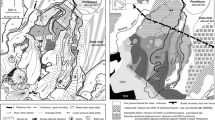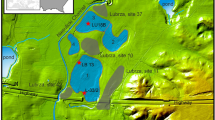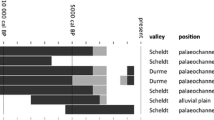Abstract.
An environmental reconstruction of the last 10,000 14C years of a frequently flooded wetland ecosystem in the lower Magdalena valley in northern Colombia is presented, on the basis of a multi-disciplinary study of the sediments of the upper 15 m of the core from Boquillas (74°33'E, 9°7'N; 20 m a. s. l.). We used the following studies: pollen, lithology, organic structures, clay mineralogy, soil and sediment geochemistry, and δ13C values. The chronology is based on 13 AMS radiocarbon dates; the humic acid fractions were used in the case of seven samples. Pollen from local origin (swamps, open grass-rich vegetation, and gallery forest) show the development of the wetland area. River-transported pollen from a greater distance (dry forest, montane forest, Alnus) show changes in river activity and reflect large-scale changes of climatic conditions in the Momposina basin. From c. 10,010 to 9370 uncal B. P. (zone BQS-Ia) the river system was of high energy, as inferred by the lithological changes. The landscape was dominated by open grass-rich vegetation with gallery forest along the streams. A marked representation of Alnus and montane forest taxa indicate significant water transport and river dynamics. Climatic conditions were dry. From c. 9370-8430 uncal B. P. (zone BQS-Ib) wetlands were isolated from the main river system, and clayey sediments with kaolinite, smectite and illite as the main minerals accumulated in a lower-energy environment. Climatic conditions were dry and changes in the seasonal precipitation favoured the expansion of the gallery forest. From c. 8430 to 8040 uncal B. P. (zone BQS-Ic) low values of river-transported pollen indicate dry climatic conditions and open vegetation became more abundant. The flooding frequency of the Boquillas site diminished. From 8040 to 4900 uncal B. P. (zone BQS-Id) the Boquillas site was dominated by open vegetation with patches of gallery forest along the streams. Supply of river-transported allochthonous pollen (from many sources) was minimal. Clay minerals from the sediments suggest variable temperature and precipitation. From c. 4900 to 1550 uncal B. P. )zone BQS-II) the site was within the reach of the main river system as is the case today. Frequent flooding, coinciding with peaks of river-transported grains of Alnus and high sediment supply, point to high precipitation in the composite catchment area of the Magdalena, Cauca, San Jorge, and Cesár rivers. High values of phosphorous in the upper part of the core point to the presence of a pre-Hispanic civilization, approximately from 2000 uncal B. P. onward. Construction of an extensive drainage system allowed irrigation as well as drainage depending the annual cycle of precipitation. The landscape was significantly modified and allowed an extensive crop production on a system of raised fields.
Similar content being viewed by others
Author information
Authors and Affiliations
Additional information
Received May 18, 2001 / Accepted June 15, 2001
Rights and permissions
About this article
Cite this article
Berrío, J., Boom, A., Botero, P. et al. Multi-disciplinary evidence of the Holocene history of a cultivated floodplain area in the wetlands of northern Colombia. Veget Hist Archaeobot 10, 161–174 (2001). https://doi.org/10.1007/PL00006928
Issue Date:
DOI: https://doi.org/10.1007/PL00006928




